This week ROTOR announced their first entrant into the power meter world with their new ‘ROTOR Power’ product. The ANT+ compatible head unit measures and reports individual left/right power output – making it one of numerous new power meter products to offer the left/right metrics. However unlike some of the other crank based left/right units out there – this unit does independently measure left/right power on each crank arm.
By leveraging the existing ANT+ power meter device profile, it will to function with ANT+ power meter head units available today (total power), as well as supporting those newer head units that support the left/right power balance standard (such as the Garmin Edge 500 and Edge 800).
In addition to these metrics they’ll be introducing two new metrics being added to the ANT+ Power Meter profile: ‘Torque Efficiency’ and ‘Pedal Smoothness’. Torque efficiency speaks to the ratio of positive and negative power – in other words, how much your pulling up versus pushing down. Pedal Smoothness is how even your pedaling is over the course of the stroke. This is similar to Spin Scan as found on a CompuTrainer.
These two new metrics aren’t quite ratified yet within the ANT+ device profile for power meters, but are nearly there and expected to be complete ahead of the release of the ROTOR power meter. Once that’s done – it’ll be up to head unit manufacturers like Garmin, Timex, CycleOps and others.
The ROTOR power meter measures the power individually per leg, with both sides having four strain gauges each. When it comes to calibration, each of the the two crank arms are calibrated independently. In order to calibrate, the left crank must first be brought to the 12PM position (pointing straight up), following which the unit will record the calibration value of that side. Then, you pedal 180* and thus switch position with the right crank arm moving to the 12PM position. A calibration value is then recorded for that side.
In talking with the team they did confirm that an end user will be able to do a static load test should they wish to.
On battery life, the unit has two CR2477 batteries, which are end-user changeable. The unit respects the ANT+ low voltage battery transmission standards and will warn you prior to the batteries running out. You can see the two coin cell battery pods located on each side in the images above (drive-side) and below (left side):
(Note that in these show floor pieces, the plastics were rapid prototypes and may have some rough edges that aren’t present in final production versions.)
The ROTOR crank will allow over the air firmware updates via ANT+. They anticipate putting together an iPhone app similar to what Quarq has done with their QALVIN app, enabling either end users or bike shops to update the firmware on the unit as required. They noted they spent a bit of time ensuring this was done correctly as they felt this offered a significant benefit to the end user.
Between the two sides of the crank, the right side (drive train side) is considered the master. Power data is funneled from the left side to the right side, and then from the right side to the head unit. This is similar to how the Garmin Vector works, as well as Polar/Look pedals. In the event of loss of the left side (i.e. battery dies), the unit will still continue to function. However, in the event of loss of the right side (again, battery dies), no power information from the left side will make it to the right side.
Note that cadence magnets are not utilized in the ROTOR power meter.
From an installation standpoint the unit features a 30mm UBB axle design which allows it to be installed on both 24mm and 30mm BB systems. The system is available in 170, 172 and 175mm arm lengths. On a road bike it’s compatible with the 130 MAS and 110MAS (Micro Adjust Spider), while on a mountain bike it’s compatible with the XC2 MAS. Road bikes are compatible with all 130 & 110 BCD, 10 & 11 Speed, oval and round chain rings. The mountain bike meanwhile is available for all 104/64 & 110/74 BCD 10 & 11 speed, oval & round chain rings.
At present, the price point for the ROTOR power meter will be €1,690 euros – or approximately $2,210US. It’s expected to be available in time for Christmas.
In addition to the power meter, they were also showing off their recently released ROTOR Flow crank arms. These €485 ($606US) crank arms are designed to be more aerodynamic. They note a time savings of 26.4 seconds for a 200 watt rider…over the course of an Ironman race (112mi/180km).
In the explanation I received, the difference in aerodynamics comes from the junction where the crank arm attaches to the spider – which has been changed to funnel the air differently. Additionally, you can see the slightly rounded edges on the cranks themselves.
The aerodynamic setup does add about 30g to the weight of a traditional Rotor 3D configuration – and is available in the following crank lengths: 150mm, 155, 160, 165, 170, 172.5, 175, 175.5, 180.
As always, if you’ve got questions I’m happy to drill down and get the answers. Thanks for reading!
FOUND THIS POST USEFUL? SUPPORT THE SITE!
Hopefully, you found this post useful. The website is really a labor of love, so please consider becoming a DC RAINMAKER Supporter. This gets you an ad-free experience, and access to our (mostly) bi-monthly behind-the-scenes video series of “Shed Talkin’”.
Support DCRainMaker - Shop on Amazon
Otherwise, perhaps consider using the below link if shopping on Amazon. As an Amazon Associate, I earn from qualifying purchases. It doesn’t cost you anything extra, but your purchases help support this website a lot. It could simply be buying toilet paper, or this pizza oven we use and love.

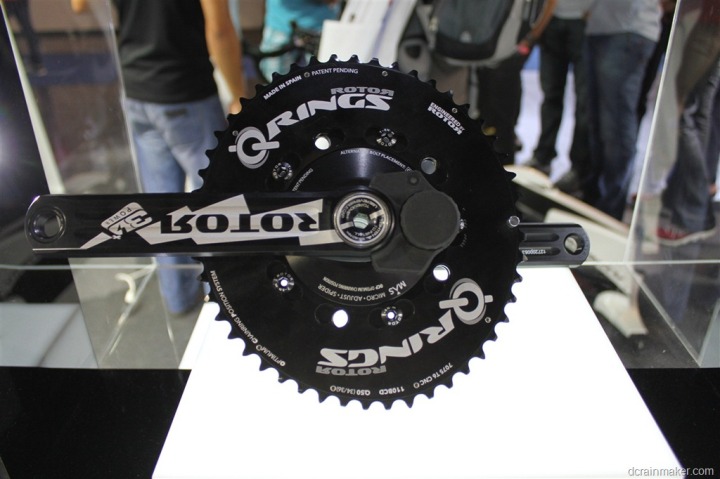
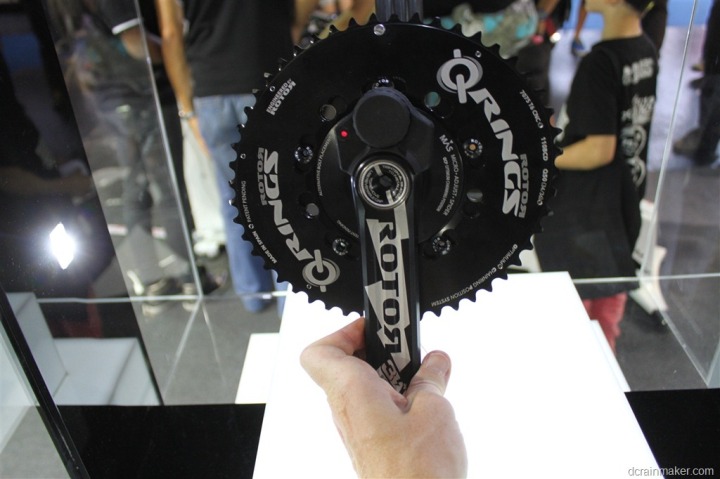
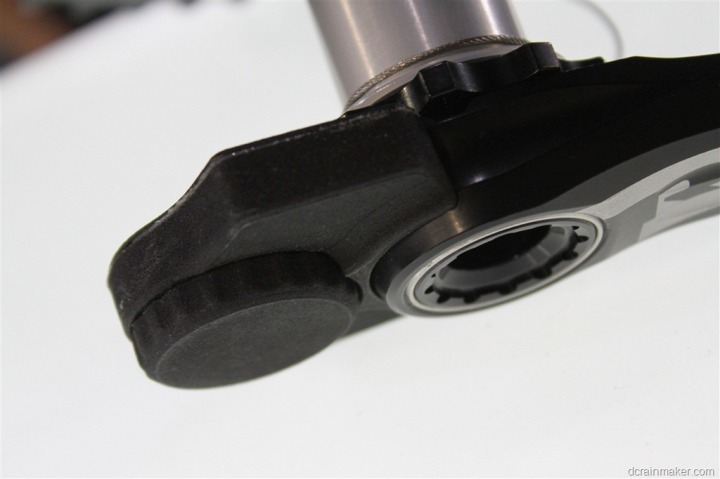
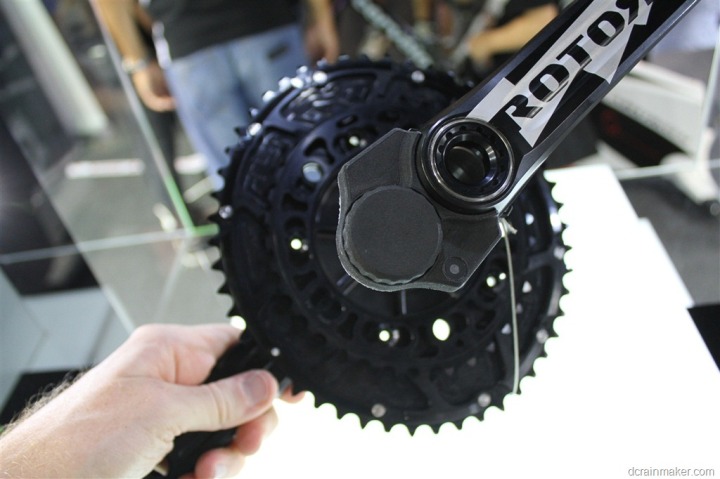
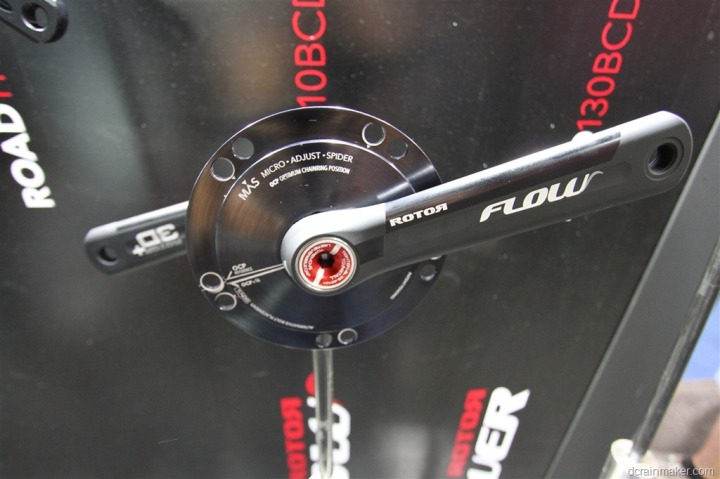
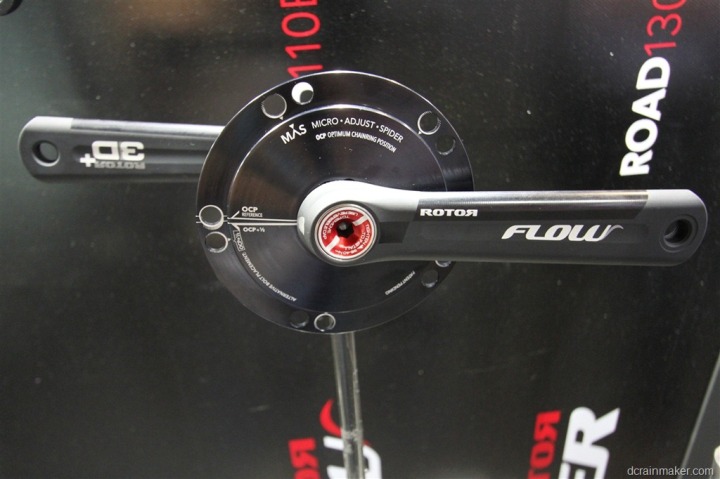
















Since non-round chainrings result in a non-uniform cadence (for a constant chain speed), proper determination of power from torque requires instantanous cadence determination. Do you know if they are doing this? Also I am very sceptical of “torque efficiency” metrics since body weight needs to be supported somewhere, and if I choose to support it on pedals that static contribution to force shouldn’t have any implication on metabolic efficiency. I’m curious what Rotor’s algorithm is.
Hi, the algorithm does not allow for ego mass or anal-retentivity. Sorry.
First, cadence can’t be measured instantaneously. It’s time based.
Second, power is time based and it doesn’t matter what your cadence is, even using oval chain rings.
P = (delta Work)/(delta Time) where work is force * distance.
Peter: I just saw your comment. Cadence can be defined instantaneously, just as velocity can. They’re both derivatives of something versus time. In the case of cadence, it’s proportional to the rate of change of crank angle.
With round rings, it works out fairly well to assume the cadence during a pedal stroke = the average cadence during that pedal stroke. But with oval rings, this assumption isn’t as good.
You need cadence to get power (or equivalently, angular velocity) because the gauges measure torque, and the proportionality constant to get from torque to power is angular velocity.
I think it’s fair to say they recognize this issue since non-round chainrings are their specialty. Presently Power2Max is the only crank-based power meter I know should be accurate with eccentric chainrings.
Good comment generally. One question/nitpick, while mathematically we can work out instantaneous things like speed, cadence, if we have a function, how does one measure it instantaneously? Idealised math is not real-world engineering.
Oops, to nitpick myself: A continuous function.
Does this have a thermocouple(or thermometer for calibration), like the updated P2M does?
This looks very promising.
Could you please find out if they are intending to produce a 144 BCD version of this powermeter for track cyclists?
I wonder what benefit will come from ‘Torque Efficiency’ and ‘Pedal Smoothness’.
While it is interesting to see that info and people have been talking about “pedaling in circles” for years will they be able to apply it?
I believe a recent study found that while people who paid attention to their pedaling efficiency did have minor gain they quickly forgot about technique if they were distracted or were under stress (e.g. a big climb).
I subscribe to the high RPM technique myself and can see the benefit, it’s easy to apply & has an immediate effect on my performance.
Trying to maintain the holy-grail of perfect pedaling technique in accross a variety of terrain will be difficult.
Finally, when i ride MTB i use a lot of upstroke power on steep climbs to keep my legs turning over however this never happens on road so would this type of measurement be best for off road?
Cheers, D
According to Rotor UK (link to rotoruk.co.uk)
they are using the Mep lab power measurement system by AIP. See link to aip-mep.com
The force vector information is very interesting. The way to improve your efficentcy is to have good feedback of what your doing. If the system enebels this which it looks to from the screen shots then it’s very interesting.
I do hope the ANT+ power profile gets updated properly for this. It is what I always thought made the pedal based systems very interesting.
During the Eurobike, we also tested it with the O-Synce Navi2Coach GPS unit and the differential power worked fine. So that is another alternative which will be available in Oct. in the US and around the world.
I’d be looking at these if they’d make the power cranks available in the same short lengths as their other cranks. I’ve been using 155s for years, love ’em. I realize those are getting wee short, but I could probably get used to a more common 165, if they’d offer it.
Would also be a big sellig point (IMO) if they worked with road triples.
Hello, checking if you have retested the Rotor power cranks?
I know they have just come onto the market and just questioning there accuracy and durability.
Any additional info would be greatly appreciated
thx
JP
I’m currently on the waiting list for a unit. They’re holding off on media folks getting units until they clear out customer backlog.
I have a Rotor Power Meter on backorder currently. Hoping it should come in within the next month. I had a quick question that you may know the answer to. In reading through the manual online, you have to calibrate the right and the left side. Will my Garmin Edge 800 realize that it’s actually calibrating two power meters to the unit? Or will it try replacing the first calibration with the second? It also says that the Rotor Power Meter won’t require recalibration every ride. Hopefully I’ve explained that clear enough.
Thanks,
Shane
No, the Edge doesn’t understand it. But, my understanding was that you essentially do one, then the next, and then it pairs through the previous. The Edge doesn’t know any differently, but ultimately it’s just talking to one.
Again, my understanding is fairly limited here.
Wondering if u have any updated info. I am trying to choose between this and a powertap. Besides the obvious cost difference, what are your thoughts?
I’d go with the PowerTap. I’m hearing about lots of issues with the Rotor at this point. I know that Rotor is working on them, and making progress, but I don’t think we’re going to see stability until later this year.
Can you elaborate a bit on the issues?
There’s issues with stability of power data, spikes, and thus accuracy. I don’t have a ton of information, but am seeing it from a number of different folks sending it over. All of those people are working with Rotor (and have been for months). But ultimately, it’s still not solved yet.
That is unfortunate. I really liked the price point. I guess I will look for an SRM on ebay as I don’t want to be “married” to a set of wheels. Thanks for you help. I have been seeing the same issues on a few different posts, and sent an email to Rotor to inquire, but have not heard back. I would still get it if this could be fixed with a software update, but if its mechanical, I doubt they would upgrade old consumers out of the goodness of their heart.
I’m user of both PowerTap G3 and Rotor Power.
I’ll completely agree with the issues regarding power spikes. Also Rotor doesn’t provide accurate cadence data. Worst issue to me is however the delay in receiving data to the monitor (Edge 500 in my case). For PowerTap G3 it’s about 1 second. For Rotor it’s about 3 seconds!
That kind of delay makes it quite difficult to train eg. 10 second sprints. Also adjusting your pacing at TT events is very difficult. Of course you’ll get the avg data quite OK but it doesn’t help during the race / training.
I’d like to have some kind of comment on this when/if there will be an in-depth review of the Rotor Power.
PS. Would go with either another G3 or some time tested crank based power meter as of now. I feel kind of beta tester. I’m confident that the Rotor will work but I’ll expect that to happen at season 2014…
I have a Rotor which finally arrived after a 7 month wait a few weeks ago. Power and cadence seem stable – no dropping of signal or spikes – although I am getting lower readings by something like 20% (by feel at the moment have yet to do a side by side test) over a powertap g3. Also my max power in a 10 sec sprint never goes above 700w whereas on the powertap it was over a 1000. Velotech, the UK distributor, says the Rotor is just more accurate but as the powertap is supposed to be accurate to within 1.5% I still don’t get it. Looking forward to a Rainmaker test of the Rotor in the usual comprehensive way ….- is this planned?
I’ve just bought a rotor power Lt and I’m also seeing a drop of about 20% power compared to PT and vector readings. I sent it back to velotech but they also say its working as it should (despite my .fit data showing the contrary). The bike shop are offering to exchange for vector but I’m not happy! Did you get anywhere with this issue?
No luck for me either on the regular version, I finally gave up back this fall.
Hey,
I’d be very interested to get more news on this device… I’m was waiting for Vector but screw Garmin (way too long) ! Then I was considering Power2Max as THE option but I’m still relucant regarding the limitation in term of cranks (Q-XL Rings; O-Symetric;…). But I’d prefer to know more from Ray before going for the Rotor.
Cheers,
Nico’
Hi IronNico & WillR-
At the moment Rotor hasn’t sent me a unit. We do talk from time to time, and I’m sure we’ll talk again late next month at Eurobike.
The challenge I have right now is that everything I’m reading – everything – from really smart people with just as much technical depth and willingness to trial and error as I, to people with less technical depth – is that the units continue to have issues, significant ones too. And the update rate has slowed a fair bit as well (as far as firmware updates). While sometimes if a company is slow in providing me a unit to test for a bit, I’ll go out and buy one, given the cost of the unit, and the fact that everything points at a number of issues – I’m hesitant to do so. This is in part because I’m just too swamped with other products right now, and specifically, other power meters. So to put something else at the back of the queue to review a product that by all accounts is broken is a tough choice to make. I wish I had more time (or, simply, wish that it wasn’t broken). Obviously, there may be someone out there with a perfectly functioning unit – I just haven’t heard a single voice from that camp yet.
Anyway, hope that helps clarify a few things.
Do keep in mind that this morning on the Garmin investor conference call they confirmed availability in less than 60 days. This is in line with what retailers inside and outside the US have reported. As always, it’s certainly a case of see it when you believe it with Vector. But the stars seem to be aligning there.
so far, didnt encounter that many issues with the Power Meter. I have two of them at the moment.
It’s the “many” part that still leaves me worried. I’m more looking for “didn’t encounter any issues”.
well… the only ‘many’ i had was that i couldn’t get the Powermeter connected to the Rotor Power software 0.9 thus it was fixed by installing the software on a pure Windows based system and not a bootcamp installed Windows on a Mac.
Both of the powermeters are giving (+/-) the same output, though it remains difficult to tell due to the all-changing circumstances, but based upon perceived exertion they come out fairly close.
I have one installed on a Giant TCR Advanced SL0 ISP BB86 with gold PF convertors from Rotor and another one on a Canyon Speedmax CF 9.0 Pro 2013 PF 68,5 with the same convertors. I’m aware its not the best combination, but so far everything is working fine.
i didnt encounter problems with ordering; one came in december and the other one in may all by mu Holland LBS.
In the time of getting the first one i mentioned your name to Christie O’Hara to let you test the PM:
@ChristieROTOR you should send
@dcrainmakerblog one of the few powermeters for review. most comprehensive reviews ever.
@vincentengel yes, love @dcrainmakerblog reviews & spoke 2 him @eurobike but right now we are putting all customers 1st as demand is so high
@vincentengel @dcrainmakerblog but hoping our marketing crew can get him one to review soon!! #ROTORpower
the last tweet was on 3rd of February this year, but apparently so far they didn’t dare to send one in?
and yes… finally i got issues as well; bought my 1st one in december 2012 (still fine no issues) second one i bought in June, on this one; the right crank is not working anymore. tried to upgrade both powermeters with new software (SW8). 3 out of 4 arms successfully connected to the sofware by ant-dongle. 4th DS-Crank after 61% it didnt work anymore, since that moment no blinking leds/or signals anymore. left arms is okay and i hoped i can still use that signal but it transmit first to the right arm to pass the signal to the garmin, so little bit useless now.
noticed some Gel inside the battery compartment, which is probably coming out of the crank arm, but i dont blame it to that cause this morning it still worked. it simple stopped connecting after the upgrade
Advanced
from Rotor:
Hi Vincent, many thanks for your enquiry and for using Rotor products.
For some reason the connection between your PC and the Rotor Power was cut down. If this happens all the information of the Rotor Power is lost, so there is no connection at all. The only way to repair this is to load the original files that we store here at Rotor for every single crankarm. This load must by done by our oficial distributor who have been trained and have the necessary software tolos for this purpose.
Please contact the store where you purchased your Rotor Power and return it to the local distributor.
For further information or concerns do not hesitate to contact me.
I bought new power meter 30 days ago. I have 7 bikes, have been using SRM for 3 years. Have 2 power taps. Owned iBike and Quarq and I can say without a doubt this power meter is off, way off not just a little rode 105 miles with two riders, one weighed 80 lbs pound less than me and the other 40. Altough they never were on the front, nor did they put in or cover any attacks. The smaller gentlemans power was just under mine and the 40 pound diff was a bit higher. The power readings from this ride were 30% lower than a dozen rides recorded with other power meters of similar rides in the past. Not off a little but a ton!!! Any thoughts, from intelligent people with a lot of experience and understand the relationship between watts and Kj’s
Upgrade to SW8 – it makes a significant difference – see post below. Just make sure your USB dongle is very close to the unit – you do not want the signal dropping out as this May require you to send the unit back for rebooting.
Hi everyone,
I am thinking of buying a power meter. I am between Power2max an Rotor Power. After reading these comments I have lots of doubts about Rotor Power. Do anyone still have issues with Rotor?
Hi all – here’s an update on my take on the rotor powermeter situation following my upgrading to SW8. The unit seems now to be bang on the money from an accuracy point of view and it’s very consistent at least on rollers. I set up a G3 powertap with a separate head unit to compare and at first was a bit crest fallen when I again got a lower reading from rotor – not as much as before but still 20 or so watts at 200. I then did a weight calibration test on both units and they were both within 1% – the powertap was .93 and the rotor .6. So I was a bit puzzled. What I then did was zero meticulously the powertap. What this entailed was locking the back axle in a turbo trainer without clamping the roller then spinning the rear wheel and then applying the rear brake so as to totally de-stress the powertap strain gauges. I then recalibrated the PT with a zero torque reading with the back wheel off the ground. I have the PT set to Autocalibrate but zeroing like this at the start should ensure the right starting point and the Autocalibrate then should look after the temp etc changes that would occur during a ride.
I then hooked up the Rotor to the user software and meticulously zeroed it too. I then did 2x 25 mins at around 70 cadence and 200 watts – nothing too arduous as a) I’m out of shape after a couple of months off the bike and b) because I wanted to be able to hold a very steady power output so I could compare power readings between the two units. What I found was that at the outset the units were pretty much matching but as time progressed the powertap started reading higher at the end of the 25 mins by about 15 -20w – bear in mind this was a consistent 75 cadence in the same gear on rollers so the change has to be down to the PT. I recalibrated at the end of the first set and retried with pretty much the same result. The variation of around 10% was surprising given I was in a well ventilated shed out of the sun and with little temp variation during the sets except of the mechanical friction produced variety.
A couple of other points to note – the rotor was way more smoothed than the PT using both 3 sec average and immediate – the new software. This still leads to a bit of a lag but it’s not that problematic. The other thing is that the cadence seems to still suffer from the vagaries of the accelerometer technology which might result is power reading issues on rough roads. I noticed this when I stood up on the rollers and my technique lead to less smooth riding – as I sat down again despite not reducing cadence the jerk caused by the transition lead to lower cadence and therefore power readings for a moment. I’ll report back on whether this manifests itself on the road. Generally pretty happy with the unit after the shaky start but still a bit more time needed and mabe a little software work still required.
Hope this is helpful and would be delighted to hear views.
Will
Thanks WillR for your comments. I finally went for the Rotor Power… let’s see how it works.
Thanks WillR for your comments. I finally went for the Rotor Power… let’s see how it works.
Abraham, how are you finding the Rotor PM?
@Jawaad,
Hi, I didn’t buy it yet. I was about to buy it, but I decided to wait. Still thinking what to do…
Just to share.
Rotor power does not work well with the Garmin FR 910XT. Drop out of power happens consistently. EDGE 510 works perfectly with no dropout.
Have you reached out to Garmin or Rotor support?
I had the same problem the first days of use.
You just need to move the 910xt a little bit closer to the PM; a 4-5 centimeter is enough.
For example, I had the 910xt mounted on my handlebar’s left side and I experienced some dropout; moving it to the rigth fixed the problem for me.
I had the same issue with a Navi2Coach, I had to move it from handlebar to stem.
Hope it helps a bit.
I’ve only been in contact with the rotor folks. They think that 910xt’s weaker antenna is the cause. I tried to set the recording to 1 second but to no avail.
Finally, I decided to get the Edge 510. Did a side by side test and indeed the 910xt drops the data but the edge 510 never dropped. Problem solved. 910xt best stays on the wrist for it’s intended purposes :)
Edge 510 satellite acquisition is damn fast btw.
In addition IMHO, even if it works perfectly, 910xt with its limited data field is not as satisfying especially if I want to have the power metrics. 510 is just awesome when paired with PM
Rainmaker:
“Would I buy it: At this point, it’s too early to say. Up until last week I would have said a resounding “no”, however their Software Update #8 sounds like it has addressed a number of major issues that were outstanding. I’d like to see how those results stand up to longer use, as well as my own testing later this fall.”
And now ?
A “Deep Reviev” would be nice.
A review is likely in the cards for January-ish or early February.
I will have the Opportunity to buy the Rotor at a special discount this weekend. I was about to buy a Power2Max. I am confused. Anybody can help me to drive the decision with Pros and cons. Thanks Bilgin
Hi @all!
Is there any way to change the MAS from 130 BCD to 110!? I´m using the 130 and I want to take the 110 one for race. I don´t know, if the right crank is depended on the MAS or if the cranks are working on their own!?
Thank you for reply
Hi Everyone,
Just as a quick and recent update…. I have recently purchased a rotor power meter which, after reading Ray’s comments in the 2013 power meter buyers guide, realised was a bit of a gamble. My experience thus far:
My first unit simply didn’t work. There was only one occasion it picked up power and that was on my 810. Could not get it to work with my 910xt. This was on the SW7. I managed to update the firmware on the left crank but couldn’t even get the right crank to register on my computer via ANT+. Changed the batteries and everything. Right crank was simply dead…not a great start.
I had that unit replaced with a more recent unit which shipped out with the SW8 firmware. This unit picked up perfectly and straight away. Mind you, I can still confirm there significant issues reading the 910xt power…you really do have to be within 10cm of the crank to get a reading.
Onto the actual power I am receiving. It seems ROTORs strength is also its weakness, being the left and right individual power meters. The right seems to read fine though the left power meter fades in and out on a very cyclical basis (very evident in garmin metrics with both power peaks and troughs and a balance distribution which reads half along the 50/50 line and half along the 100% right line). I have read this on my 810 and 2 separate 910xts. No amount of calibration seems to fix this issue. I am sure this is an issue that will get amended with firmware updates in the future, though I and many others believe these are too few and far between.
Hope others have had better luck.
“Rainmaker replied
December 3, 2013 at 6:05 pm #44
A review is likely in the cards for January-ish or early February.”
I’ve been waiting very excited.
I hope you are on the way.
And a question to Rotor Power user. Is all o.k. with a navi2coach.
Thanks Kurt
Kurt, I can confirm that the Rotor PM works ok with a Navi2Coach.
I had some problem with the old SW7 firmware with power and cadence dropout.
I moved the N2C from the handlebar to the stem and the issue was resolved at 99%….then with the SW8 firmware everything was smooth.
“Rainmaker replied
December 3, 2013 at 6:05 pm #44
A review is likely in the cards for January-ish or early February.”
And now??
I picked one up today. Is there a way to tell what version firmware is installed?
Thanks
If you crack open the ROTOR Power Software (download from their site), with the ANT+ usb stick it’ll connect and report back the software level.
So far I have to say my experience with this power meter hasn’t been positive. I think (hope) that my device isn’t running the latest firmware as cadence and power was fluctuating significantly. I’ve also had no luck pairing using the garmin USB ant dongle. I’ve got the dongle sitting on the crank (USB extension) and it’s just not working. I’d really recommend potential buyers to consider this product carefully before purchasing.
Here’s hoping I haven’t bought a total lemon.
Bit of an update. I’ve ridden with this pm a few times now. Not sure what was going on during my first ride but things seem to be more stable now. Not sure why, I haven’t changed anything.
Also the supports guys at rotor helped me troubleshoot why I could not connect the ant dongle. User error, not the hardware. Turns out I had the garmin ant agent running. Shut this down and connected straight away.
I just pick up my bike with the Rotor Power installed. I’ll let you know if I have issues or not.
@Rainmaker What’s with a Deep Review?
@All The Rotor in “my” shop 170mm 110 MAS have 564 g only Spider and Arms (without Rings,BB,Screws,Batterie…)
The Rotor specs says 505 g ~ +11,5%
Is this still o.k.?
And your?
I’m cooking away on it.
I had many issues such as power spikes and inconsistent readings. I had to pull the battery out of left crank all the time to do a full reset as the power just stopped recording etc (tried new batteries etc). I finally got sick of it and sent it back and in exchange for a SRM.
They lost a good customer with me as I have 3 x Quarq Elsa and 2 x SRM units. I won’t be going back.
What software version is the best to have on the Rotor Power ?
And how to upload it in to the crank ?
I’m having Power balance issues, incorrect cadence readings an doubt regarding my avg power ……
Tx,
Ced
Hey Rainmaker.
I have just purchased the dual sided Rotor Power MAS 130 with their Q Rings. I have downloaded the Rotor Power Software, can I use the IN-Power software to get OCP position or is there other software out there to allow this if I can’t? I can’t find an answer to this online.
Thanks
Den